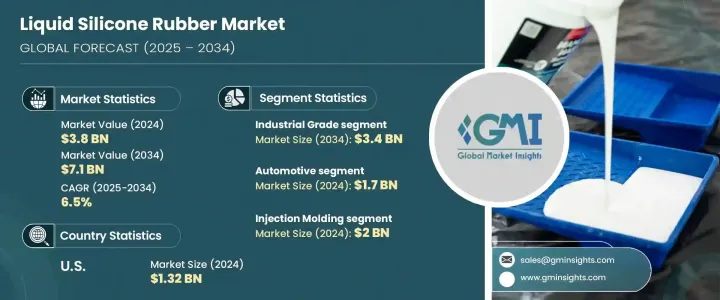
세계의 액상 실리콘 고무 시장은 2024년 38억 달러로 평가되었으며 CAGR 6.5%를 나타내 2034년에는 71억 달러에 이를 것으로 추정되고 있습니다. 열 안정성, 무해한 배합으로 알려진 LSR은 정밀 사출 성형에 있어서 매우 중요한 역할을 하고 있어 복잡하고 고성능인 부품의 제조에 최적인 재료가 되고 있습니다. 소형화, 경량화, 지속가능성에의 세계의 시프트가 현저해짐에 따라, 엄격한 품질 기준이나 규정 준수 기준을 채우기 위해서, LSR에의 의존도가 높아지고 있습니다. 특히 전기자동차의 급속한 진보는 고정밀 LSR 부품에 새로운 기회를 가져오고 있습니다. 세계적으로 제조 규모가 확대되고 신뢰성이 높고 생체 적합성이 높은 재료에 대한 수요가 높아지는 가운데 기술 혁신을 가능하게 하는 LSR의 역할은 그 어느 때보다도 중요해지고 있습니다.

2024년 공업용 LSR 분야의 매출은 18억 달러였고, 2034년에는 34억 달러에 이를 것으로 예상되고 있습니다. 제조업체들이 온도 변화가 심한 환경에서 제품 수명과 성능을 향상시켜야 한다는 압박에 직면함에 따라 산업용 등급 LSR이 신뢰할 수 있는 솔루션으로 계속 부상하고 있습니다.
| 시장 범위 | |
|---|---|
| 시작 연도 | 2024년 |
| 예측 연도 | 2025-2034년 |
| 시작 금액 | 38억 달러 |
| 예측 금액 | 71억 달러 |
| CAGR | 6.5% |
액상 실리콘 고무 시장의 자동차 분야 점유율은 44.7%로 2024년 평가액은 17억 달러에 달했습니다. LSR은 고성능 가스켓, 씰, 회로 기판 및 커넥터의 단열재 등의 부품에 필수적입니다.
2024년 미국의 액상 실리콘 고무 시장 규모는 13억 2,000만 달러였고 자동차, 의료기기, 소비자용 전자기기 분야의 왕성한 수요가 계속 성장을 이끌어냈습니다. 미국 시장은 2034년까지 연평균 6.9%의 꾸준한 성장률을 나타낼 것으로 예상되며, R&D, 품질 보증 및 스마트 제조 공정에 대한 투자가 주요 성장 촉매제 역할을 할 것으로 전망됩니다.
세계의 액상 실리콘 고무 시장 주요 기업은 Wacker Chemie, Dow, Reiss Manufacturing, Momentive Performance Materials, Shenzhen Inno Silica, Elkem Asa, SIMTEC Silicone Parts, DuPont, Shin-Etsu Chemical Industries, Avantor, KCC, CHT 그룹 등이 있습니다. 이러한 기업은 뛰어난 내약품성과 내열성을 가진 차세대 LSR 배합을 개발함으로써 시장을 개척하고 있습니다.
The Global Liquid Silicone Rubber Market was valued at USD 3.8 billion in 2024 and is estimated to grow at a CAGR of 6.5% to reach USD 7.1 billion by 2034. Liquid silicone rubber (LSR), a high-purity, two-part elastomer, continues to gain remarkable traction across diverse industries due to its exceptional material properties. Known for its outstanding flexibility, superior thermal stability, and non-toxic formulation, LSR plays a pivotal role in precision injection molding, making it the material of choice for manufacturing complex, high-performance components. Its chemical inertness, resistance to UV and aging, and ability to perform under extreme environmental conditions make it highly sought-after in next-generation applications. As the global shift toward miniaturization, lightweighting, and sustainability becomes more prominent, manufacturers are increasingly relying on LSR to meet stringent quality and compliance standards. Rapid advancements in medical devices, consumer electronics, and automotive engineering-especially electric vehicles-are creating new opportunities for high-precision LSR parts. With global manufacturing scaling up and the demand for reliable, biocompatible materials rising, LSR's role in enabling innovation is becoming more critical than ever.

In 2024, the industrial-grade LSR segment generated USD 1.8 billion and is anticipated to reach USD 3.4 billion by 2034. This upward trend is being driven by expanding use cases in insulation, sealing, and gaskets, particularly across the electronics and advanced manufacturing sectors. As manufacturers face growing pressure to enhance product longevity and performance in fluctuating temperature environments, industrial-grade LSR continues to emerge as a reliable solution. Its high tensile strength, durability, and excellent moldability are supporting mission-critical uses in complex, high-stress applications-especially where traditional materials fall short.
| Market Scope | |
|---|---|
| Start Year | 2024 |
| Forecast Year | 2025-2034 |
| Start Value | $3.8 Billion |
| Forecast Value | $7.1 Billion |
| CAGR | 6.5% |
The automotive sector in the liquid silicone rubber market held a 44.7% share and reached a valuation of USD 1.7 billion in 2024. With automotive engineering shifting toward electric and hybrid drivetrains, manufacturers are prioritizing materials that endure heat, pressure, and constant vibration. LSR is proving essential for components such as high-performance gaskets, seals, and thermal insulation for circuit boards and connectors. As electric vehicle adoption accelerates across key regions, LSR's usage is expected to expand significantly, supporting the industry's demand for precision, safety, and thermal resilience.
United States Liquid Silicone Rubber Market generated USD 1.32 billion in 2024. Robust demand from automotive, medical device, and consumer electronics sectors continues to drive growth. The U.S. market is forecasted to grow at a steady CAGR of 6.9% through 2034, with investments in R&D, quality assurance, and smart manufacturing processes acting as major growth catalysts. The country remains a key influencer in global LSR application innovation and adoption.
Key players in the Global Liquid Silicone Rubber Market include Wacker Chemie, Dow, Reiss Manufacturing, Momentive Performance Materials, Shenzhen Inno Silica, Elkem Asa, SIMTEC Silicone Parts, DuPont, Shin-Etsu Chemical, Avantor, KCC, and CHT Group. These companies are advancing the market by developing next-gen LSR formulations with superior chemical and thermal resistance. Strategic OEM partnerships and expansion of automated production lines are strengthening global supply chains. Sustainability-focused initiatives, including recyclable LSR variants, are further shaping market dynamics.